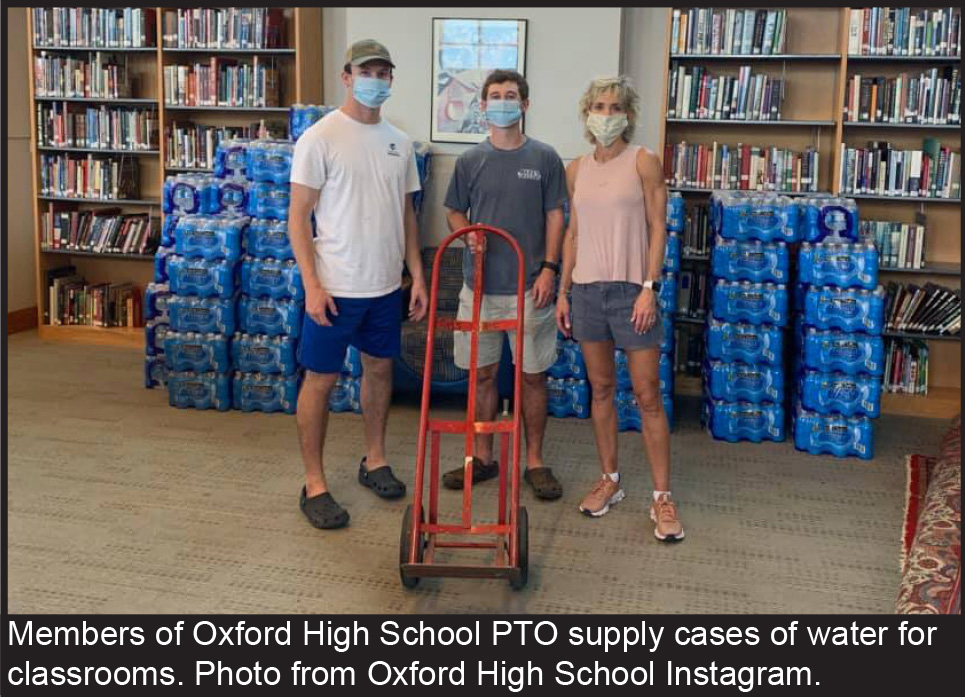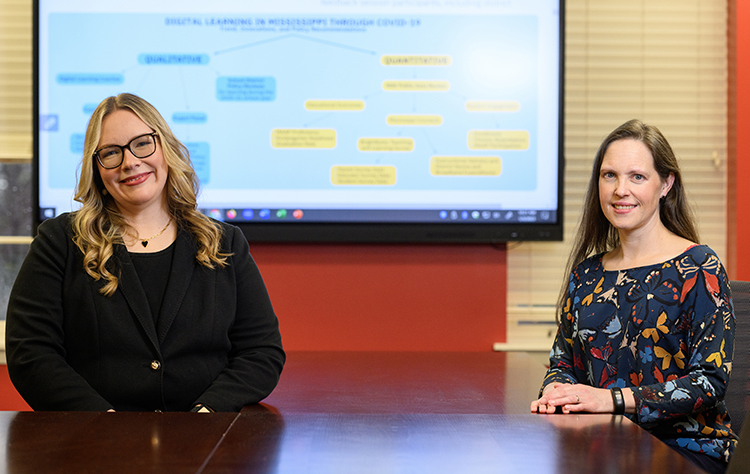
Some individuals have chosen to remain anonymous for this article; their names have been omitted.
I remember being afraid on March 11 when news of the virus known to me at the time only as “novel coronoavirus” began to strike fear in Americans. My dad had recently been released from the hospital after a heart attack, and he’d suffered over the past two years with other ailments, going in and out of the hospital. I remember spraying down my desk, office lobby, and coworkers’ desks with Lysol at least three times that day. The university students were on Spring Break holiday, and I was terrified they would bring it back to Oxford with them.
An event I was planning for National Geographic Society had just been cancelled, and that was the first I saw COVID-19 in print. I hunted through Kroger, Walmart, Larson’s, both Dollar Trees, and three Dollar Generals, and I still couldn’t find toilet paper or paper towels. It searched for three days before I would finally find some at Walgreens.
Across our town, we were afraid of what would or could happen to jeopardize our way of life. I was crushed upon hearing of the passing of Kevin Malloy, an Ole Miss speech teacher I remember fondly for his dedication to the Ole Miss MBA Speaker’s Edge. At the same time, my best friend was battling COVID-19 in Nashville and finally recovered a month later.
Film festivals have gone online, weddings have been postponed or downsized, and the way we learn has been greatly reexamined. Working at a university, every day I see the great care being taken to find solutions to safely reopen, but at the end of the day, higher education is “optional,” whereas K-12 is not.
The fact that many families depend on school meals, daytime occupation of young children, and structured and measured education cannot be understated. But our country is now grappling with the pressing question: What is the true cost of in-person education during a pandemic, and can our individual cities handle the challenge?
The Fear of Infection Is Real
“My take after our first meeting, well, I was freaking out. I didn’t feel like our administration was taking into account how much contact we would have with students,” said Staff A, who works in the Oxford School District. “After we pointed out the mask issue, they made a requirement for masks.”
Masks haven’t been preventing infections in our state, and the continued upward climb of infection rates and deaths has many parents, students, and educational staff and faculty concerned.
Mississippi has quarantined 2,035 students and teachers as 444 tested positive for COVID-19, according to an article published by the Mississippi Free Press on August 17, 2020.
Proper mask cleanliness, wearing, and usage are legitimate concerns, especially for young children and special education students, and even more so when considering outdoor activities during North Mississippi August–September heat indexes, when temperatures historically hover in the 84–88 degree range.

Thankfully, access to clean water, proper hand soap, paper towels, and hand sanitizer are not a concern for the well-funded Oxford School District. The CARES Act has also provided funding to both Oxford and Lafayette County Schools, presumably to help ensure adequate PPE supplies.
“I think my biggest fears currently are surrounding the teachers. Older people are more susceptible to COVID-19, and the school is refusing to give teachers proper protection, because they consider face shields ‘helping.’ Children are most likely going to pass along the virus, even if they are asymptomatic, to their teachers,” said Audrey Flaschka, an 11th-grade Oxford High School student.
The constant battle has been between solely virtual learning versus a hybrid version. Many do not want to jeopardize their health, but aren’t necessarily viable for health-related leave. With the schools making decisions for a hybrid environment, many are still heavily exposed.
“I am pregnant, so yes, I am nervous about returning to school!” said Blair Jackson Flint, a Dual Enrollment English Composition Teacher at South Panola High School. “Personally, I would love to do fully online teaching for my own safety,” Flint continued. “However, I do think that my school is doing a great deal to protect me and the other teachers since we will physically be in school at all times.”
When asked how the Oxford School District is handling requests to work remotely due to underlying health conditions, pregnancy, or close interaction with susceptible family members, Oxford School District Superintendent Brian Harvey noted that the school will comply in all situations with the American Disabilities Acts and “other related regulations,” which we assume implies the Family Medical Leave Act.
Schools Delayed to August 24
On August 5, the Oxford School District Board of Trustees voted (3–2) in favor to delay students’ return to the Oxford School District until Monday, August 24. Teachers would return to their classrooms August 17. Although this follows the recommendation of Mississippi State Department of Health representative, Dr. Thomas Dobbs, many parents were upset with the decision while many teachers felt relief.
“I think it was the right decision by Dr. Dobbs to delay,” said OSD Superintendant Brian Harvey. “I know many disagree with the decision, but I think it was for the best.”
“A lot of the moms were really upset that school was pushed back two weeks. I understand that people are in a pickle, but they did it for a few reasons,” said Staff A. “It gave teachers time to get classes ready and parents to make a different decision if they wanted to do so.”
Staff A felt that it was primarily parents who lean on the school environment to occupy their kids while they are at work, or because they are overwhelmed with having them in the home so much, not lower economic families struggling to provide meals or a safe environment.
“Moms who have been vocal about it have said it’s not fair to minority students; however, those aren’t the parents speaking up,” said Staff A. “Eighty-eight percent of the children coming back in person are white, and only about 60 percent are coming back in person total.”
Since June, the number of parents opting for virtual learning environments has continued to climb in the Oxford School District. According to Brian Harvey, 62 percent have chosen face-to-face learning, and approximately 38 percent have opted for solely virtual learning.

Protocols in Place
Mary Beth Smith, a geography teacher at Lafayette Middle School, feels comfortable with the school’s changes meant to keep her and students safe. The Lafayette County School District started classes in early August beginning with a two-phase system, dividing students into Red and Gold groups to introduce them to the environment separately before integrating them. Lafayette County School District announced five cases of COVID-19 on August 14.
“I think we are making the best decision about opening at Lafayette with the red/gold group start,” said Smith. “I never feel unsafe in my classroom because we are six feet apart at all times and we are wearing masks.”
The Oxford School District is making similar adjustments, but are not using the same shift system. They will be taking each child’s temperature, but not until they have been driven on a bus, been given breakfast, and assigned to a table.
“We just can’t scan temperatures before they get off the bus,” says Staff A from Della Davidson. “We don’t have the manpower. They are giving them breakfast in the cafeteria, then kids are sent down the hall, then teachers will check their temperature before they go into the classroom.”
Staff A elaborated that if they do have a temperature that is in the danger zone for COVID-19, the parent or legal guardian will be contacted. If they cannot be reached, someone will take their child to the parent’s place of work to remove the child from the school campus.
“Kids will have scheduled recess times and room change times. We have transition times for teachers that move to reduce hall congestion,” said Staff A. Staff A also mentioned that the way the flow in the hallways will occur is different than in the past, decreasing crowded walking areas and reducing possibility of contamination.
We All Have to Do Our Part
“It is weird as a mom to send your kids masked into a school you cannot even go into,” said Danica Boyd, the Director of Children’s Ministry & Community Life at Grace Bible Church. “They won’t have an open house; I have to drive through to pick up packets.”
Danica not only leads the children’s ministry for Grace Bible Church, but she also was a school teacher for many years at Regents and in the public school system.
“I have never been anxious about my kids going to school before, but this is a little bit different.”
Danica spoke about the issues of having to keep a mask on a child’s face, especially all day in a school environment. “I think that’s just going to be really hard on a teacher,” says Boyd. “And for kids to get in trouble for not wearing a mask, or a teacher not enforcing it.”
But Danica, like many, is committed to doing what it takes for her children to have a quality education and be able to have face-to-face interaction safely with their peers at school.
“It is a multi-faceted situation for everyone,” said Boyd. “Some kids need food, or a break from their home environment. Even kids coming from a wealthy background may have parents not around and need that outlet. There is no one-size-fits-all in this situation.”
Wearing masks is a crucial action for our entire community. We must protect others daily by social distancing, wearing PPE, and staying home as much as possible.
“We won’t find out the day it happens,” said Brian Harvey, pointing to the delay of onset of symptoms, as well as the delay in testing results. “As rapid testing becomes more available, it makes accurate contact tracing more probable.”
Oxford School District is committed to providing rapid testing as soon as it becomes available, and has plans to create additional, separate facilities on campus by mid-September to isolate symptomatic students until a parent can retrieve them.
Educate Yourself
If you are not aware at this point of symptoms or procedures, please visit the CDC and Mississippi State Department of Health websites for more information.
Return to School Plan for Lafayette County School District can be found here and here.
FAQ Return to School Place for LCSD.
COVID-19 Protocols for LCSD.
Policies for Oxford School District can be found here.
FAQ Return to Learn for OSD.



